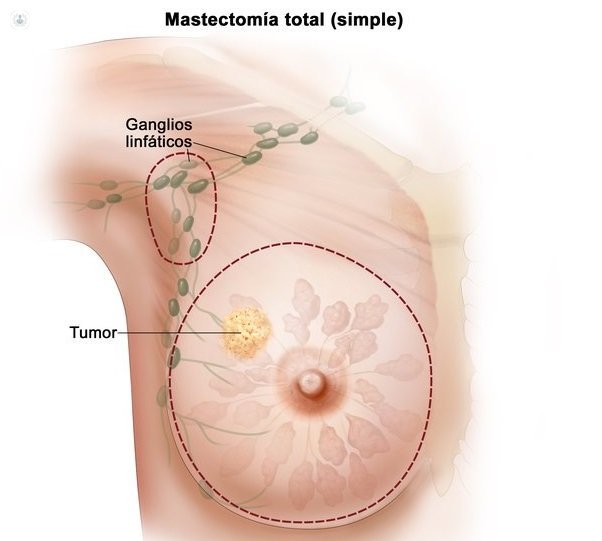How is breast cancer surgery?
Written by:Breast cancer affects each year 25,000 women in Spain. It is, therefore, a health problem first order. Now, speaking of breast cancer should clarify that it is not a disease that can be generalized. On the contrary, there are many breast cancers as women with breast cancer. Graphically it can be concluded that there is no single type of breast cancer in Spain, but every year there are 25,000 kinds of breast cancer.
Varieties of breast cancer
 The plurality of breast cancer is such that each tumor has many variables: according to the histological type of tumor, may be fundamentally of these four classes, although there are more less frequent classes:
The plurality of breast cancer is such that each tumor has many variables: according to the histological type of tumor, may be fundamentally of these four classes, although there are more less frequent classes:
- DCIS: it occurs within a breast duct without invasion outside the duct.
- Infiltrating Ductal: originates in the cells of the milk ducts that circulate breast milk, but unlike the previous one , no invasion outside the duct.
- It LCIS: is given within a breast lobule.
- Lobular: it occurs in the cells of the breast lobules where breast milk is produced, and no invasion beyond the breast lobules.
Other variables include tumor size and location thereof. Although most often there is a single tumor, there may be more than one in the same breast, or even tumors in both breasts that are diagnosed simultaneously.
Also each tumor has specific hormonal characteristics that define him as more or less aggressive and more or less likely to respond to hormonal and chemotherapy treatments.
To further complicate things, the tumor can be localized in the breast, have spread to the armpit on the same side, or have spread to the rest of the body such as bone, liver or brain. In this case we say that the tumor has metastasized. Moreover, although the cause of cancer is multifactorial and many external agents are responsible, there are other cases in which the genetic cause of cancer is. It occurs in people who are carriers of the BRCA 1 and BRCA 2 genes. In these cases genetic studies are performed close relatives to rule out the presence of these genes.
Finally, breast cancer is not exclusive to women: 1% of diagnoses of breast cancer affecting men.
Prevention is the best weapon against cancer
Prevention has become the best weapon to treat this pathology, being self palpation or exploration of the woman who initiates the process when a lump is detected in the breast.
But not all breast cancers present with a lump, or there are cases where the bulk is hidden in a large breast. Therefore, prevention studies with screening mammograms are essential to arrive early diagnosis. It is recommended that these studies regularly from 45 or 50 years to 65 approximately.
Treatments for breast cancer
Currently , the breast cancer management is multidisciplinary, so are several specialties which come together in solving this health problem, such as general surgery, plastic surgery, gynecology, radiation oncology, medical oncology, rehabilitation and psychiatry. All with the help of radiology, nuclear medicine and pathology, which are key to the diagnosis.
Surgery, radiotherapy, chemotherapy, hormonal therapy and treatment with monoclonal antibodies are the main ways to act against breast cancer.
Surgery in breast cancer
Surgical, therapeutic options are available:
1. On the breast:
Conservative Surgery is performed when the tumor is small relative to the size of the breast. The size of resection of breast tissue should not exceed 4/5 of the breast, because what we seek with conservative surgery is to treat cancer with an aesthetic result best. The techniques in this section are two:
- Lumpectomy , or removal of the tumor with a margin of resection.
- Lumpectomy or removal of part of the breast tissue that does not exceed 4/5 of the breast.
Radical Surgery: This is done when you can not make conservative surgery. It consists of a total mastectomy including the fascia of the pectoralis major; ie where the breast tissue sits.
2. On the armpit.
In all cases of breast cancer must be radiologically study the armpit through ultrasound, because the breast tumor spreads, usually via the lymphatic system into this territory. If the ultrasound shows no suspicious lymph nodes, it is used to sentinel node testing to ensure the diagnosis. This test is injected into the tumor a radioactive contrast hours preoperatively. The contrast migrates to the armpit, as could make tumor cells, and is collected by a first node, called sentinel node so. Then the surgeon will detect this axillary node using a small incision, is removed and analyzed at the time. If the node is affected by tumor manifestly and is a locally advanced cancer, and you have to perform axillary lymphadenectomy, ie, removal of all lymph nodes in the armpit on the same side.
If doing axillary exploration is detected one or a suspicious lymph nodes and punctured, obtaining a result of cancer, it should be an extension study to see if the tumor has affected other parts of the body. It is done by two tests:
- Bone scan to see if there is bone metastases
- PET-CT for detecting metastases in other parts of the body
If the extension study is negative breast cancer is locally advanced. In this case, if the tumor has a size that does not allow conservative surgery can be applied chemotherapy before surgery to shrink the tumor and to perform breast-conserving surgery. In the procedure, the radiologist places a metallic marker in the center of the tumor, to locate it in case there is a complete response to chemotherapy. relevant and chemotherapy is given, according to response is selected from conservational surgery or radical surgery in the event that the answer is not so effective.

Breast reconstruction after surgery
In cases of conservative surgery, the breast is reshaped through surgery Oncoplastic. While radical surgery can reconstruct the breast immediately resection of it, by the so-called immediate reconstructive surgery, but can also postpone reconstruction.
Breast reconstruction is done immediately, usually with a silicone prosthesis called Expander, because it is inserted under the pectoral muscles and then, on an outpatient basis, is filled with liquid to obtain the proper volume. Currently Expander change the definitive prosthesis is silicone.
But reconstruction can also be done with techniques in which the patient 's own tissue is used and have different denominations and technical latissimus dorsi or rectus muscle transposition. Each case has its indications and contraindications, which are valued by the specialist in plastic surgery. In almost all these cases it has to perform an operation with the contralateral breast for symmetrization of healthy breast affected by the tumor.
No specific preparation is needed for this type of surgery. Although there will always be valued the existence of associated as heart disease or diabetes mellitus, in order to apply the appropriate treatment before surgery, during surgery and after surgery.
What are the risks?
All surgeries carry a risk. However, breast cancer surgery carries no increased risk in the immediate postoperative period and depends on the technique that was applied. For example if you did lymphadenectomy, the possible complication may be the lymphedema or increased retention arm and forearm lymph. In this case it should be treated early and do rehabilitation member.
In the event that the patient has undergone a prosthetic reconstruction will be possible complications that promptly explained by specialist General Surgery .
Following Surgery for breast cancer
The patient of breast cancer should be treated within a multidisciplinary team that will signal the optimal time for each therapy (radiotherapy, chemotherapy, hormonal therapy ...) and appropriate doses. revisions will be made every three months the first year, six the second and third, and annually after the third year. This, in general, but it depends on each case.
Once you have left the operating room, if the patient does not need UVI passes to a unit or PACU postanesthetic, commonly known as AWAKENING, and from here to the hospital room. The need for analgesia is usually very discreet and once you do not need fluid therapy or medication intravenously may be discharged. Drainage is not a contraindication for discharge and removed in the office a few days later. Thus, the average hospital stay is usually two days.


